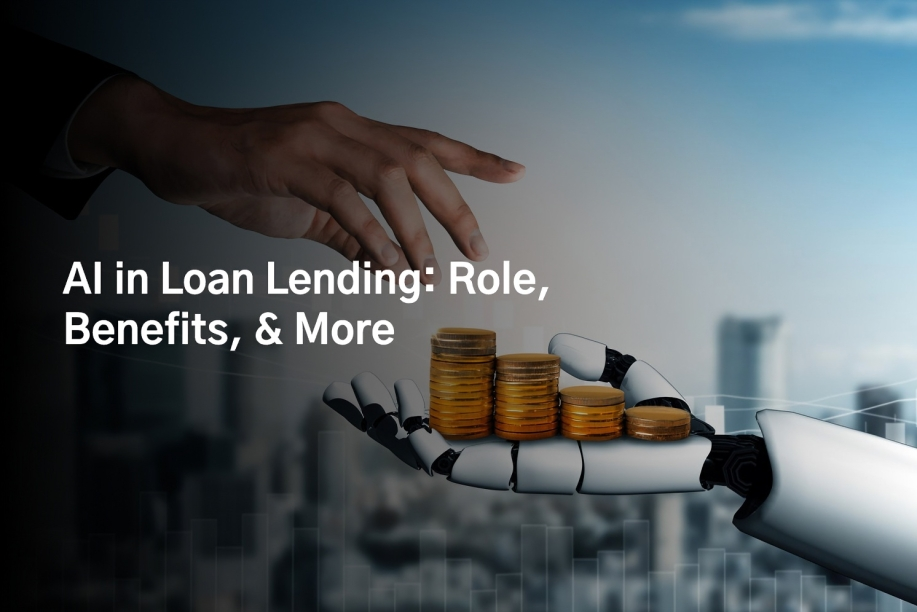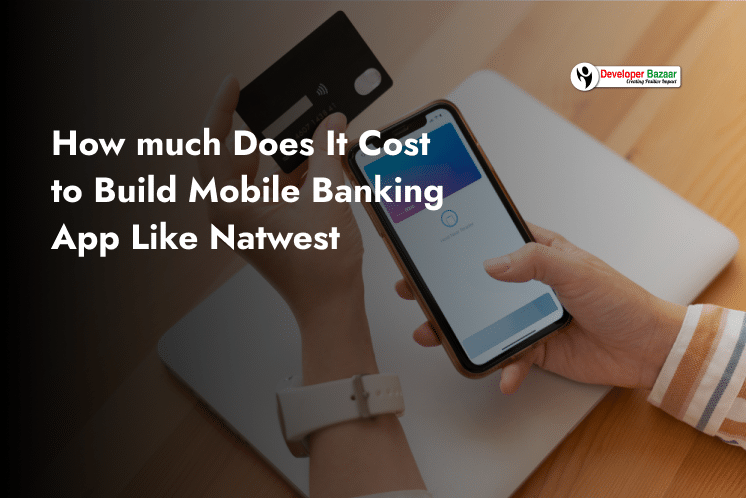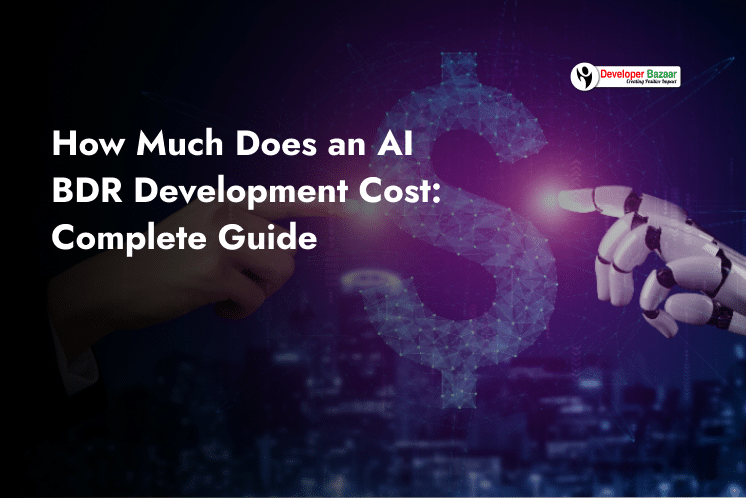Table of Contents
ToggleAI is changing many industries, including loan lending. AI in loan apps speeds up operations, improves risk management, and provides more personalized user experiences. AI has made the loan process easier and less paper-intensive by using machine learning, language understanding, and prediction tools, allowing both lenders and borrowers to use financial services with greater effectiveness.
Particularly in the area of credit scoring, AI has greatly changed the way loans are approved. Previously, lenders focused on a few factors, such as income relative to debt and credit history. Many times, this strategy excluded those who didn’t fit the usual financial mold. AI is currently able to analyze a far greater variety of data. A person’s financial situation, spending patterns, and even social media information (with consent) can all be analyzed by machine learning. Lenders are better able to assess a borrower’s capacity to repay a loan as a result. As a result, credit is now available to more people, including gig workers and freelancers, who were previously usually excluded.
Because AI is so good at predicting outcomes, it can be a great tool for risk management. Identifying fraud in the loan sector is a key area where it is useful. Artificial intelligence (AI)-driven loan applications succeed at identifying any irregularities that could point to fraud. When AI looks at transaction data, it can quickly recognize unusual changes that help prevent issues before they get worse. By learning from previous fraud cases, these AI models continue to improve their ability to spot new frauds. Also, the entire loan process is more accurate and dependable due to AI automation, which reduces human error.
AI automates a lot of steps, which greatly speeds up and improves the efficiency of loan processing. AI makes everything run more smoothly, from loan applications to approval. Virtual assistants and chatbots, for example, can respond to frequently asked questions from borrowers whenever they want without the help of a human worker. As a result, borrowers can receive help at any time and without having to wait. AI also speeds up the review of documents by quickly getting relevant information from uploaded files. Tasks that used to take weeks can now be done in just hours or even minutes.
AI faces major challenges. Privacy is an important issue. To function properly, AI systems require large amounts of data, which raises privacy issues. To keep borrowers’ information secure, lenders must implement strong security measures and be open about how they use it.
AI bias is an additional issue. AI models that are trained on biased data will likewise make biased decisions, which may be unfair to certain borrowers. This can be avoided by carefully designing AI systems and closely monitoring how they take care of humans.
AI has a massive impact on the customer experience. It makes borrowing more customer-centric by providing personalized services. AI can use predictive analytics to determine which types of loans or repayment plans are best for each individual, making loans more personalized. For example, AI can identify customers who could benefit from funding or alert borrowers in advance of time if they are having difficulty making payments, allowing them to receive help before things get worse. This type of personalization promotes trust and long-term relationships between lenders and borrowers.
In the real world, AI is currently changing the way loans are granted. AI is being used by startups like Kabbage and Upstart to speed up and improve the equity of lending. Upstart uses artificial intelligence (AI) to examine factors like employment history and education, increasing loan availability and decreasing late payments risk. Kabbage uses AI to check the financial health of small businesses instantly, allowing for quick loan approvals—something that traditional methods couldn’t do nearly as fast.
👀 Also Read: How Does Klarna Work: Klarna Business and Revenue Model Explained
This blog looks at how important AI is for loan lending apps. It explains the benefits, challenges, and real-life uses of AI, showing why it’s likely to be the future of the lending business:
Understanding AI in Loan Lending
AI in loan lending refers to the usage of artificial intelligence (AI) to improve the loan distribution process through the use of intelligent computer programs such as machine learning, predictive analysis, and natural language processing, which makes the loan application process faster, more accurate, and easier for borrowers. AI is used to improve the processing, approval, and management of loans, making the entire process more efficient and user-friendly.
To obtain a loan through traditional lending, one must manually gather documentation, handle a large amount of paperwork, and rely on human judgment. Errors may result from this slowing down the process. This is made simpler by AI, which automates important duties to minimize errors and delays. AI tools, for example, can automate the process of document verification, which is an important part of lending, saving time and effort.
When determining a borrower’s chances of repaying a loan, machine learning is extremely helpful. Traditional credit scores don’t always provide a comprehensive view of an individual’s financial status because they only consider a limited number of financial details. On the other hand, AI looks at a wide range of additional factors, including spending patterns, income trends, and even social media activity and utility payments. This broader view makes lending fairer and more inclusive, helping people who don’t have typical financial backgrounds to still be able to get loans.
Through chatbots and virtual assistants that offer 24/7 support and prompt question answers, artificial intelligence improves customer interactions. Because they receive prompt responses and unique help, customers are more satisfied. AI is also capable of predicting the best loan options for each individual and suggesting flexible payment plans.
By making loan lending quicker, fair and equal, and more customer-focused, artificial intelligence is changing the sector. Banks and lenders’ perceptions of risk, loan decisions, and customer relations may all be changed.
👀 Also Read: How to Build an Intelligent AI Model: An Enterprise Guide
Key AI Technologies in Loan Lending Apps
Through faster processes, better risk management, and improved customer interactions, artificial intelligence (AI) technologies are drastically changing the loan lending sector. Both lenders and borrowers benefit from these modern AI technologies in loan lending apps, which help reduce paperwork and improve productivity. The key AI technologies that are causing these changes in loan lending apps are discussed in more detail here:
1. Machine Learning (ML) for Credit Scoring
When it comes to the application of AI in loan distribution, machine learning is important. Traditional credit scoring techniques mostly use limited data, such as an individual’s income and credit history, to figure out their loan-repayment capacity. However, these facts can be insufficient to fairly determine someone’s creditworthiness. In contrast, machine learning has the ability to analyze huge amounts of data, including unnecessary information about social activities, spending patterns, and even online behavior. Through the identification of patterns in all of this data, machine learning models can provide a more comprehensive and accurate method of credit scoring.
In order to make more accurate predictions, machine learning models continuously learn and improve. Because of their increased ability to identify risks, lenders are able to provide loans to borrowers who are more likely to repay them while lowering the possibility that they won’t. Furthermore to making lending easier and transparent, ML-based credit scoring makes loans available to those without a traditional credit history, such as freelancers and contractors who work independently.
2. Natural Language Processing (NLP) for Customer Interaction
NLP is another important AI technology that is greatly improving the loan lending sector. NLP allows loan apps to use chatbots and virtual assistants to provide 24/7 support for customers. These chatbots with AI capabilities are able to understand and respond to consumer inquiries instantly. They are able to give information on various loan options, loan application status, and repayment options.
By providing quick responses to frequently asked questions, Natural Language Processing (NLP) simplifies things for users. Service agents have less work to do and customers receive assistance more quickly as a result. Chatbots with NLP capabilities can also guide users through the loan application process step-by-step, simplifying and improving user experience. Additionally, NLP can perform sentiment analysis, which helps lenders understand how customers are feeling. This gives lenders the opportunity to modify their communication style, resulting in more effective and customized interactions.
3. Predictive Analytics for Risk Management
Another innovative technology in loan lending apps is predictive analytics, which is powered by AI. In order to identify trends and make educated guesses about potential future events, predictive analytics analyzes historical data. It helps in determining whether a borrower will be unable to repay a loan. This makes it easier for lenders to choose who they will lend money to.
In order to determine the risk of lending money to someone, predictive models examine financial data, spending trends, and behavior. This helps lenders reduce late payments, manage risks in advance, and make well-informed decisions. Lenders can provide customized loan products that best meet the needs of each borrower by using predictive analytics to modify loan terms.
4. Robotic Process Automation (RPA) for Efficiency
An AI technology called robotic process automation (RPA) helps in automating lengthy processes in the loan application procedure. There are a lot of manual tasks involved in loan applications, such as entering information, document verification, and making sure everything aligns with rules and laws. By handling these tasks automatically, RPA speeds up the loan application process and lowers the possibility of human error.
Robotic Process Automation, or RPA, can swiftly extract important information from uploaded documents, verify its accuracy, and instantly update records. This makes sure the data is handled accurately and consistently while also speeding up the loan approval process. RPA lowers operating expenses while increasing the effectiveness of loan lending applications.
5. Fraud Detection with AI
For loan lending apps, AI-powered fraud detection is an important technology. Lending fraud is a major issue, and AI is known to be highly effective at recognizing and reducing these risks. In order to identify suspicious activity that may indicate fraud, such as identity theft or faked information in loan applications, machine learning algorithms can analyze patterns in real time.
Artificial intelligence (AI) models are constantly learning from new data, allowing them to detect and detect fraud of all kinds. Early detection of potential fraud by AI allows lenders to take prompt action to stop it, saving money for both the borrower and the lender. Manual methods simply aren’t able to check and catch fraud in real time with the same accuracy and speed.
6. AI-Based Personalization
AI plays a major role in the growing trend of personalization in the financial industry. AI is now used by loan lending apps to generate user-specific loan offers. The AI examines user data, such as income, spending patterns, and financial objectives. The AI can offer loan options that fit to each borrower’s unique needs based on this information.
AI can identify borrowers who would benefit from loan repays and present them with new options in advance. AI can also generate flexible repayment plans that fit to each individual’s financial situation. The relationship between lenders and borrowers is boosted by this type of customized help, which promotes trust and loyalty.
Machine learning, natural language processing (NLP), predictive analytics, robotic process automation (RPA), and AI-based fraud detection are just a few of the AI technologies that have a major impact on loan lending apps. Loan apps are becoming easier to use, more effective, and improved due to these technologies. They improve the experience for customers while helping lenders reduce risks and run their businesses more smoothly.
In the loan lending sector, we are likely seeing even more innovative concepts and instruments as AI keeps improving. These modifications will improve the loan process’s efficiency, speed, and availability for all.
👀 Also Read: Cost to Develop an AI Chatbot App like Ask AI
Role of AI in Loan Lending Apps
Many industries are rapidly changing due to artificial intelligence (AI), and the loan lending sector is one that has been greatly affected. The process is becoming easier, more efficient, and more user-friendly for both lenders and borrowers due to the integration of AI in loan lending apps. Everything from how a person’s credit is measured to how consumers communicate with lenders is changing due to artificial intelligence. This improves the experience for borrowers, lowers risks, and helps lenders in making better decisions. This detailed look will explore the important roles that AI plays in loan lending apps and why it has become an essential part of today’s lending systems.
1. AI-Powered Credit Scoring
An individual’s credit score has always been a major factor in determining their loan eligibility. The majority of traditional credit checks are based on an individual’s credit history, which is occasionally insufficient to fully grasp the situation. AI’s use of machine learning for analyzing a wide range of data has completely changed the way credit scoring operates. This provides a fuller picture of a person’s capacity to repay a loan. With AI, lenders can make better credit decisions by considering not only a person’s credit history but also other factors like their spending habits, transaction history, job background, and even social behaviors (with permission from the person).
To determine a borrower’s ability to repay a loan, AI-powered credit scoring systems look at a variety of data. It is easier to determine whether a borrower will repay their loan because they are able to spot trends and patterns that traditional methods frequently ignore. People without traditional credit histories, such as gig workers or freelancers, can still be eligible for loans by using alternative data. As a result, credit becomes more widely available, allowing more people to obtain loans and building financial inclusion.
2. Fraud Detection and Prevention
Lenders worry a lot about fraud, and the traditional methods of identifying it can be slow and ineffective. AI greatly improves fraud prevention and detection in loan lending apps. Immediate analysis of transaction data by machine learning models can identify any odd patterns or behaviors that could indicate fraud.
Through learning from previous fraud cases, AI is very good at identifying new forms of fraud. For example, it can immediately alert the appropriate individuals if it observes patterns similar to previous fraudulent activity, helping in preventing fraud before it increases. Financial institutions and their clients are safer due to this proactive approach. AI also adds an extra layer of security by using tools like voice verification and facial recognition to make sure the person applying for a loan is who they claim to be.
3. Automation of Manual Processes
Document verification, data entry, and compliance assurance are just a few of the many manual tasks that are usually involved in loan processing. These tasks take a lot of time and are now liable for errors. Robotic Process Automation (RPA), a type of automation driven by AI, has greatly simplified these tasks. RPA can speed up the process and minimize human error by automatically extracting information from uploaded documents, verifying the details with databases, and updating records.
Automating routine processes allows loan lending apps to approve and provide loans more quickly. Borrowers who need quick access to funds benefit from this efficiency, which also helps lenders cut expenses and free up staff members for more important tasks. Customers find the lending process easier and more convenient due to the quicker service and increased efficiency that come with using AI.
4. AI-Powered Chatbots for Customer Support
The loan process heavily relies on customer service, and chatbots powered by AI have changed customer service delivery. Natural Language Processing (NLP)-based AI chatbots can communicate with customers in real time and help them with inquiries about loan products, eligibility, application status, and repayment plans.
Chatbots are available at any time of day or night, which is an important benefit over traditional customer support, which typically only operates during specific hours. Everything functions better when chatbots handle basic inquiries, freeing up human customer support agents to handle more complex issues. AI chatbots are able to guide people through the loan application process step-by-step, simplifying it and lowering the possibility of errors.
Chatbots can modify their responses by understanding customer emotions with the help of AI-based sentiment analysis. The chatbot can either pass the conversation to a human or respond in a more thoughtful manner if the borrower seems upset or nervous. In addition to improving the overall customer experience, this customized assistance promotes trust between the lender and the borrower.
5. Risk Assessment and Predictive Analytics
Any lending company’s success depends on its ability to properly determine risk. By estimating the probability that a borrower won’t repay a loan, AI greatly improves risk assessment through predictive analytics. Because these predictive models are trained on historical data, they are better able to analyze an individual’s financial patterns and determine their risk level than conventional techniques.
AI’s rapid data analysis speeds up the decision-making process for lenders. By reviewing a borrower’s spending patterns, financial history, and other indicators, AI can, for example, determine whether they are likely to miss a payment. By doing so, lenders are able to take early action, such as providing borrowers who appear likely to have payment difficulties with new repayment plans. Artificial intelligence helps lenders lower losses and improve their overall loan management by more accurately monitoring risks.
6. Personalized Loan Products
Loan lending apps that use AI are able to offer customized loan offers that are specific to the individual needs of each borrower. AI can determine each person’s optimal loan options by examining information such as income, spending patterns, and financial objectives. Customers have a better experience due to this personalization, which also guarantees that the loans they receive are appropriate for their financial situation.
Artificial Intelligence can help in identifying which customers would profit from a loan repay with a reduced interest rate. People who might be struggling to make their loan payments can also receive early warnings from it. By providing loans that are customized for each individual, this strategy puts the customer at the center of the lending process, helping borrowers in feeling valued and understood and improving their overall satisfaction.
7. Speed and Efficiency in Loan Processing
Borrowers can get loans much more quickly and easily with AI. Because there are numerous steps where various people review and verify the information, often it takes days or even weeks to get a loan approved. However, AI may speed up the approval process greatly by using advanced automation. Immediately analysis of an applicant’s data allows machine learning models to make decisions more quickly than a human.
In a market where convenience is highly valued, quick processing helps lenders stand out and helps borrowers obtain credit quickly when they need it. The quicker a loan is approved and paid out, the more possible it is that a borrower will choose that lender over another. Artificial intelligence (AI) allows loan lending apps to meet the growing demand for quick financial services while providing a smooth user experience that meets modern consumers expectations.
8. Compliance and Regulatory Adherence
Strict regulations are in place in the loan lending sector to protect both borrowers and lenders, making compliance an important factor. AI automates checks and generates audit reports to help lending apps follow to these regulations. AI programs are able to examine loan applications for compliance issues and notify users of possible problems before they become serious.
AI systems can be trained to stay current with new laws and regulations, to make sure the lending process always follows with the law. This lowers the possibility of breaking the law, which could result in penalties and damage the financial institution’s reputation. Borrowers are also more confident when using AI tools for compliance because they know that their lender is adhering to every applicable law and regulation.
9. Improving Financial Inclusion
Loan lending apps are significantly impacted by AI, particularly in terms of expanding access to financial services. People who are typically excluded by traditional banks can benefit from AI’s ability to use a variety of data to determine who should be granted a loan. Those with little credit history, such as young adults, freelancers, and people of developing nations, are included in this category. AI makes sure that more people can obtain loans, even if they don’t fit the typical requirements.
More people can obtain credit through AI’s use of data, allowing them to fulfill their financial objectives, such as starting a business, purchasing a home, or covering personal expenses. In addition to helping individuals, this type of financial inclusion promotes the economy overall by enabling more people to participate in the formal economy while encouraging startup companies.
Artificial Intelligence (AI) is transforming loan lending apps in a number of ways. More people can obtain loans due to its help in improving credit scores, automating manual tasks, improving risk assessment, and offering customized customer service. AI improves lending for both lenders and borrowers by increasing efficiency, security, and customer satisfaction. AI will continue to grow in its impact on lending as it develops, contributing to the creation of a more dynamic and inclusive financial system.
👀 Also Read: Which LLM is Best for a Customer Support Chatbot?
Why AI in Loan Lending Apps is The Future?
The future is becoming quicker, more effective, and customer-focused due to the use of artificial intelligence (AI) in loan lending apps. The digital world of today is proving to be too demanding for traditional lending methods, and artificial intelligence (AI) is emerging as the primary technology pushing the next wave of financial services. By simplifying the procedure, cutting costs, and improving the overall experience, this modification helps both lenders and borrowers. These factors make artificial intelligence (AI) in loan lending apps the way of the future.
1. Enhanced Credit Assessment and Inclusivity
Because they only consider a limited number of factors, such as income and credit history, traditional credit scoring systems are restricted. This means that many people are excluded, including gig employees, freelancers, and those without a traditional credit history. However, AI uses machine learning to analyze a far greater variety of data, including unusual elements like transaction histories, spending patterns, and even social data (if the subject approves). This broader view helps create more accurate assessments of someone’s creditworthiness and provides lending opportunities for people who were previously excluded. AI is helping in the promotion of financial equality, which is crucial to building a more equal financial system, by improving the availability of credit.
2. Increased Efficiency Through Automation
Because AI technology speeds up the process, it is changing the way loans are handled. Long verification processes, manual data entry, and a ton of paperwork are all part of the traditional loan approval process, which can lead to huge delays. The time required to approve and pay loans is reduced by AI’s ability to handle these repetitive tasks automatically through the use of tools like Robotic Process Automation (RPA). Now, tasks that once took weeks can be completed in just a couple of hours or even minutes. Today’s consumers want things done quickly, so speed like this is important. It also helps lenders save money while reaching increasing demand.
3. Personalized Customer Experiences
AI allows loan apps to provide customers with a more personalized experience in ways that were previously impossible. AI can suggest loan options based on a user’s financial situation, repayment preferences, and future goals. The level of personalization goes above loans; AI chatbots and virtual assistants can interact with customers in real time, answer their questions, guide them through the application process, and make personalized recommendations based on their specific needs. Customers are happier and more loyal as a result of the high level of customization because they believe their lender understands and values them.
4. Improved Risk Management and Fraud Prevention
Risk management is important for any successful lending business, and AI is making progress in this field. Machine learning models can analyze large amounts of data to predict the the probability that a loan will not be repaid, allowing lenders to make better decisions and reduce risks. Furthermore, AI-powered fraud detection systems can detect unusual activity quickly, advising to potential fraud before it becomes a serious problem. This proactive approach to risk and fraud protects lenders and makes borrowing safer, thus improving trust between borrowers and lenders throughout the lending process.
5. Scalability and Adaptability
AI enables loan lending apps to grow and adjust to future needs. As more people apply for loans, AI-powered systems can handle the extra work while maintaining speed and accuracy. AI constantly learns from new information, so these systems improve over time. This adaptability allows lenders to remain competitive while meeting changing market needs and customer demands. Because AI can grow and change along with the business, it is a great technology for the future of lending.
AI in loan lending apps is the future of the financial industry because it improves decision-making on who gets loans, automates the process, provides personalized services, manages risks more effectively, and is easily scalable to handle more customers. The traditional method of lending money has many drawbacks and is insufficient to meet the needs of modern customers who prefer quick, digital services. Using AI, lenders can provide a more inclusive, efficient, and customer-friendly experience, setting the way for the future of finance.
👀 Also Read: How Much Does It Cost To Build a AI Chatbot in 2024?
Case Study: Examples of AI in Loan Lending Apps
Artificial Intelligence (AI) is changing loan distribution by simplifying, optimizing, and personalizing the process for consumers. Several financial technology (fintech) firms and banks are using AI in their loan offerings, showing the practical uses for this technology. In the upcoming sections, we will look at some key examples that show how AI is being successfully used in loan lending apps and how it is transforming the industry.
1. Upstart: AI-Driven Credit Risk Assessment
AI is being used by Upstart, a leading financial technology company, to improve the efficiency and fairness of the credit approval process. Traditional methods to credit score calculation primarily consider factors such as income and credit history, which frequently leave out individuals with non-traditional financial backgrounds. Unlike other AI systems, Upstart uses more than 1,600 pieces of data, such as education, employment history, and even academic performance, to determine a borrower’s chances of repaying a loan. By using machine learning, Upstart can give loans to more people, including those without a long credit history, as long as they show good signs of being a low risk for default based on other data. his has made it easier for more people to borrow money, while also lowering the number of loan defaults compared to the old way of lending.
2. Kabbage: Automated Loan Approvals for Small Businesses
A prime example of how AI can transform small business lending is Kabbage. In the past, obtaining a small business loan was difficult due to the extensive paperwork and risk assessment that was necessary. AI is used by Kabbage to expedite and simplify the loan approval process. Through direct connections to bank accounts, accounting software, and other data, Kabbage’s AI can quickly evaluate a business’s financial standing. This means that, compared to traditional banks, Kabbage can approve loans in a couple of minutes rather than weeks or months. Small businesses can more easily obtain the funding they require to support their growth by using Kabbage, which simplifies data collection and risk assessment.
3. Zest AI: Reducing Bias in Lending
Zest AI uses machine learning to help in making more accurate and fair loan decisions. Artificial intelligence (AI) may sometimes be biased if the training data contains unfair past ideas. This issue is resolved by Zest AI, which uses unique algorithms to identify and lessen these biases. To make fairer and better credit decisions, their models consider a lot of data. This makes it easier for lenders to approve loans for more people while maintaining a safe and fair process. Lenders are still able to effectively handle risk while more people are able to get loans.
4. LendingClub: Personalized Loan Offers
One of the best peer-to-peer lending platforms is LendingClub, which makes lending personalized through AI. The company makes use of machine learning to analyze user data and provide loans that are specific to each borrower. The artificial intelligence (AI) at LendingClub can recommend loan amounts and interest rates that are specific to each individual’s needs by looking at information such as income, spending patterns, and repayment records. Because borrowers receive options that suit their financial needs, this personalized approach not only increases customer satisfaction but also lowers the probability of loan defaults.
5. Ant Financial: AI for Fraud Detection
To improve fraud detection and prevent financial crimes, Ant Financial, Alibaba’s financial technology division, has begun integrating artificial intelligence (AI) into its lending services. Using user behavior, transaction history, and other data, the AI-based risk management system looks for trends that could indicate fraud. The artificial intelligence system helps create a secure environment for both lending and borrowing by continuously learning from new data and staying on top of appearing fraud strategies. Ant Financial has decreased fraud losses through the use of AI, increasing the security and reliability of the lending process.
How loan lending apps operate in the financial industry has changed greatly as a result of AI. Businesses such as Kabbage, Ant Financial, LendingClub, Zest AI, and Upstart are showing how AI can improve lending. They use artificial intelligence (AI) to better understand a person’s credit risk, automate loan approvals, provide loans that are modified to the needs of the customer, and more successfully identify fraud. The examples provided show that artificial intelligence (AI) is not just a passing trend but rather an effective tool that is changing the distribution and management of loans. This results in a system that is more equitable, effective, and customer-focused.
👀 Also Read: How Much Does it Cost to Hire AI Developers?
AI-Driven Features in Loan Lending Apps
The processing, approval, and management of loans have all been changed by artificial intelligence (AI). There are now features in AI-powered loan apps that speed up the process, lower risks, and provide borrowers with a more personalized experience. We examine here the key AI features that are making loan apps more intelligent, faster, and user-friendly.
1. Automated Credit Scoring
Automated credit scoring is one of the key features of AI in loan apps. Unlike traditional credit scoring, which mainly considers a person’s credit history and debt-to-income ratio, AI-driven credit scoring looks at a wide range of data using machine learning. Financial transactions, spending patterns, employment history, and even social information (if the user agrees to share it) are all included in this. AI can provide a more comprehensive and accurate evaluation of a borrower’s capacity to repay a loan by examining all of these various features. Because of this, more people including those without a traditional financial background can now obtain loans.
2. AI-Powered Chatbots and Virtual Assistants
Customer service in loan lending apps is changing due to AI chatbots and virtual assistants. These AI systems can respond to a wide range of consumer inquiries, such as helping with loan application completion or clarifying loan eligibility. They understand and respond to inquiries instantly because they use Natural Language Processing (NLP). They operate 24/7, so borrowers can get help whenever they need it. Furthermore, these chatbots are able to sense the user’s emotions and modify their responses to be more thoughtful and customized, improving the user experience overall.
3. Predictive Analytics for Risk Assessment
Risk assessment is an important step in the loan approval process, and loan lending apps benefit even more from the use of AI-powered predictive analytics. To estimate a borrower’s possibility of loan default, predictive models consider historical data, financial patterns, and other indicators. Through the examination of various elements such as spending patterns, repayment history, and income trends, AI is able to accurately predict an applicant’s potential level of risk. In addition to decreasing the probability of loan defaults, this helps lenders in making more informed decisions and assigning loans to borrowers who are more likely to make timely repayments. Additionally, lenders can use predictive analytics to identify borrowers who might experience future financial difficulties and offer early help or flexible repayment plans.
4. Fraud Detection and Prevention
AI-based fraud detection is important for the security of loan lending applications. To examine real-time transaction data and identify any questionable activity that might point to fraud, machine learning algorithms are used. In order to stay on top of emerging fraud schemes, these algorithms continuously learn from historical data. Because AI systems are able to recognize odd behavior, such as incorrect application information or odd login attempts, lenders can take immediate steps to prevent fraud. The lenders are protected by this real-time fraud detection capability, which also gives borrowers peace of mind that their financial data is secure.
5. Personalized Loan Offers
AI-powered loan lending apps succeed at personalization, which is becoming increasingly important in the financial sector. By looking at user information such as income, spending patterns, and financial objectives, AI is able to provide loans that are specific to each individual’s requirements. If someone wants a short-term loan, for example, the app can offer them personalized options with favorable terms that suit their budget. AI can also suggest loan products or refinancing that could benefit the borrower. By matching loans to borrowers’ ability to repay, this specific approach not only increases user satisfaction but also increases the probability of successful loan repayments.
6. Document Verification and Processing
One of the main advantages of integrating AI into loan lending apps is its ability to automate document processing and verification. Many documents, including identification, proof of income, and other financial records, are required when a person applies for a loan. Artificial intelligence (AI)-powered optical character recognition (OCR) can swiftly gather crucial information from these documents, verify that everything is accurate, and compare it with information in databases that already exist. Loan approvals are accelerated, errors are decreased, and the entire process is made much faster by this automation. Artificial Intelligence (AI) speeds up loan approval and disbursement by processing documents automatically, improving the borrower experience overall.
7. Loan Application Prequalification
One feature of AI-powered loan apps is prequalification, which allows users to check their loan eligibility without affecting their credit score. The application quickly looks at a user’s basic financial information and determines whether they are eligible for a loan. Both the borrower and the lender save time because this provides an early indication of eligibility before beginning the entire application process.
8. Dynamic Interest Rate Adjustments
Artificial intelligence (AI) algorithms can dynamically modify interest rates by examining borrower profiles, market trends, and risk levels. Because of this, borrowers receive interest rates that are reasonable given their financial situation and current market conditions. Additionally, it helps lenders maintain their competitiveness by dynamically adjusting rates based on risk and demand. Lenders can still turn a profit while providing better loan options due to this flexibility.
9. Payment Reminders and Default Prediction
Loan apps with AI capabilities help borrowers by expecting when they may have trouble making their payments and reminding them to do so on time. The artificial intelligence monitors a borrower’s financial behavior and reminds them when it’s time to make payments. This data is also used for predicting whether a borrower will experience future loan repayment difficulties. By identifying a risk, lenders are able to provide help or modify the payment schedule before issues arise, which decreases the possibility of defaults.
10. Customer Feedback Analysis
By examining customer reviews and feedback, artificial intelligence (AI) tools that analyze emotions can determine how satisfied borrowers are. Through reviewing of consumer feedback and reviews, lenders can identify areas for improvement and modify their products and services. This allows lenders to address problems, improve their customer experience, and continuously improve their loan offerings.
11. Seamless Onboarding Process
AI simplifies the process of onboarding new customers by automating processes like data entry and verification, which can be challenging. New users can easily and quickly create accounts, confirm their identity, and begin the loan application process with AI-powered onboarding features. This easy onboarding process reduces the possibility that users will give up during the process and helps attract more users to the platform.
AI-powered loan apps are changing the market by enabling quicker, safer, and more customized lending. AI is helpful in many ways, such as by automating credit scoring to determine loan eligibility, using chatbots to respond to inquiries, and using predictive analytics for determining risks. Additionally, it helps in fraud detection, provides customized loan options, handles prequalification, verifies documentation, and modifies interest rates according to each borrower. AI also analyzes customer feedback, reminds users to make payments, and facilitates the onboarding of new clients. These features give borrowers a better, more individualized experience while helping lenders in operating more effectively and lowering risks. AI will play a significant role in lending in the future.
👀 Also Read: Airbnb’s Business Model & Revenue Source
Challenges and Considerations for AI in Loan Lending Apps
Although artificial intelligence (AI) is changing the loan application process by making it quicker and more precise, there are certain disadvantages that should be carefully reviewed. There are significant ethical, technical, and regulatory concerns that must be addressed before integrating AI into loan lending apps, even though it can improve customer satisfaction and simplify operations. Here, we examine a few of the primary obstacles and considerations when integrating AI into loan lending applications.
1. Data Privacy and Security
Keeping data secure and private is one of the biggest challenges to implementing AI in loan apps. AI requires a large amount of data, including private and sensitive financial information, in order to make wise decisions. Because improper handling or unauthorized access to the data may result in identity theft or data breaches, this presents privacy concerns. Loan apps are bound by data protection regulations such as the CCPA and GDPR in order to protect user data. To safeguard borrower data from online attacks, they must also use strong encryption and safe data storage.
2. Bias in AI Algorithms
One major issue with AI algorithms is bias, which can lead to unfair lending decisions. Because AI systems learn from historical data, they will continue to make biased decisions if the data contains biases. This may indicate that when someone applies for a loan, some groups—such as minorities or those with less conventional financial histories—are treated unfairly. It’s important to use a variety of data that represents various demographic groups when training AI in order to avoid this. In order to identify and address biases and make sure lending decisions are equitable for all, AI systems must also be regularly examined and monitored.
3. Regulatory Compliance
The use of AI for loans creates new difficulties in following to the numerous regulations that govern the financial sector. Decisions made by AI have to align with local lending regulations, which may change by location. Lenders must ensure that AI systems follow to regulations regarding credit evaluation, data privacy, and discrimination prevention. Additionally, regulators may request that lenders provide an explanation for their loan decisions, which can be challenging when dealing with advanced AI models often referred to as “black-box” models due to their complicated inner workings. AI systems that are simple to understand and give clear justifications for their decisions must be developed in order to follow regulations.
4. Transparency and Explainability
When it comes to loan lending, applicants frequently want to know why their application was accepted or rejected. However, it can be challenging to provide a clear explanation of the reasoning behind these decisions due to the complexity of the AI models that are sometimes used. People may become unsure of the system as a result of these unclear explanations. Since deep learning is typically the foundation of AI models, they process information in ways that are difficult to understand. Explainable AI (XAI) models, which can offer concise and intelligible justifications for their decisions, should be used by lenders to deal with this problem. In addition to helping people trust the process, having AI that is easy to understand is necessary for following laws and regulations that demand transparency.
5. Integration with Legacy Systems
AI integration can be challenging for many banks and financial institutions that still depend on outdated computer systems for their operations. With modern AI technology, the outdated systems frequently don’t function well, leading to technical issues and increased expenses. In order to address this issue, lenders must either upgrade their computer systems or use advanced software that allows the integration of the old and new systems. To maximize the benefits of AI and ensure that it integrates smoothly with the current setup to increase overall efficiency, smooth integration is essential.
6. High Implementation Costs
It can be costly to use AI in loan lending apps, particularly for smaller financial institutions. AI model development, training, and maintenance require large expenditures in data systems, technology, and skilled workers. Additionally, for the AI systems to remain accurate and follow to regulations, they require frequent monitoring and updating. Smaller lenders may find it difficult to invest in modern AI tools due to these high costs. Financial institutions can use AI-as-a-Service (AIaaS) solutions, which provide scalable and more cost-effective AI options, or collaborate with fintech companies to address this problem.
7. Ethical Considerations
To make sure that lending is done fairly and responsibly, there are a number of ethical concerns when using AI in loan lending that require careful consideration. One significant worry is that AI might only use data to make decisions, ignoring borrowers’ specific situations. This data-only strategy might be impersonal and overlook significant information about a borrower’s life that could have an impact on their capacity to repay the loan. To guarantee that borrowers are treated fairly and that ethical considerations are taken seriously, lenders must strike a balance between the use of automated systems and human decision-making.
8. Customer Trust and Adoption
Getting people to trust AI-based loan apps can be challenging because these technologies are still relatively new. If they don’t understand how the decisions are made, borrowers may be unwilling to give an AI system their financial information. Lenders must be transparent about how they use AI, what data they gather, and how AI-driven lending can benefit in order to gain their trust. Borrowers can be encouraged to use these apps by being informed about the advantages of AI, such as faster approvals and offers that are specifically designed for them.
AI has many benefits for loan lending apps, including accelerating procedures, providing more individualized services, and improving risk management. But there are other important problems that must be resolved as well. Keeping user data private, avoiding algorithmic biases, following to legal requirements, being open and honest about AI’s operation, navigating outdated technology, controlling the high setup costs of AI, addressing ethical concerns, and promoting customer trust are some of these difficulties. Lenders may fully use AI to make lending equitable, effective, and user-friendly if these issues are resolved.
👀 Also Read: Mobile App Development Cost in India
Transform Your Lending Business with Developer Bazaar Technologies
As a leader in financial technology, Developer Bazaar Technologies can help you grow your lending business. Our advanced artificial intelligence solutions are here to reduce expenses, improve customer satisfaction, and make lending simpler. Through our flexible lending platform, we provide everything from intelligent fraud detection to automated credit scoring. With this platform, you can make data-driven decisions more quickly and with fewer risks. Secure, scalable, and user-friendly solutions are available from Developer Bazaar Technologies, whether you’re looking to launch a new lending service or upgrade your existing one. Count on our experience to improve your lending operations, increase productivity, and maintain your position as a market leader. Partner with Developer Bazaar Technologies today to see how our AI App Development Services can help you succeed in the future of lending.
Conclusion
Artificial Intelligence (AI) is changing the financial sector by enabling faster, more customized, and easier loan applications. The processing, assessment, and management of loans are being improved by AI technologies such as chatbots, automated credit scoring, predictive analytics, and fraud detection. However, issues like data privacy, algorithmic bias, regulatory compliance, and integrating with outdated systems are also challenges that must be overcome. AI is already being used by businesses such as Upstart, Kabbage, and Ant Financial to make lending safer, faster, and more equitable. Leading developer Bazaar Technologies is providing AI-based solutions that revolutionize lending companies. By using AI and solving these challenges, lenders can create a more customer-friendly and efficient financial system, leading to a future where loans are more inclusive and available to everyone.
FAQs
1. What are the benefits of using AI in loan lending apps?
AI in loan apps makes getting loans faster and easier. It helps approve loans quickly, checks credit scores more accurately, cuts down costs for the company, detects fraud better, and gives users more personalized experiences.
2. How does AI help in credit scoring for loan approvals?
AI-driven credit scoring uses machine learning to look at many different pieces of information, like how a person spends money, their transaction history, and their job records. This helps create a better and more complete picture of how likely someone is to repay a loan, making the credit assessment more accurate.
3. What are the major challenges of implementing AI in loan lending?
The main problems with using AI are worries about keeping people’s data private, biases that might exist in AI programs, following laws and rules, working with old technology systems, and the high costs of getting AI set up. Solving these problems is really important for successfully using AI.
4. How can AI improve fraud detection in lending apps?
AI helps in detecting fraud by quickly analyzing transaction data to find anything unusual. Machine learning algorithms can recognize patterns and spot strange activities that could mean fraud is happening. This helps lenders take action before the fraud can cause harm.
5. Is AI-based lending fair to all borrowers?
AI can make lending fair if we train the AI systems using a wide range of different and fair data, and if we keep checking for and fixing any bias. It’s also important to have good oversight and use AI in an ethical way to make sure lending decisions are fair for everyone.
6. How can small lenders afford AI-driven solutions?
Small lenders can work together with fintech companies or use AI-as-a-Service (AIaaS) solutions, which allow them to access AI tools that are affordable and can grow with their needs, without requiring big investments upfront.
7. What role does Developer Bazaar Technologies play in AI-driven lending?
Developer Bazaar Technologies provides advanced AI tools that help lenders make their lending process smoother, improve customer experience, and lower costs. Their platform can be customized to include features like AI-based credit scoring, detecting fraud, and offering personalized loan options. These tools help lenders work more efficiently and make better decisions.
8. How does AI personalize the loan lending experience?
AI makes the lending process more personal by looking at borrower information to provide loan products, interest rates, and repayment options that fit their specific needs. AI chatbots also give help right away, making the borrowing experience more customized for each person.
9. What is the future of AI in loan lending?
The future of AI in giving loans will involve more automation, better ways to judge risk, and more personalized experiences for customers. As AI keeps improving, it will make the loan process more efficient, include more people, and make customers happier with their experience in the lending industry.
10. How can lenders ensure compliance when using AI?
Lenders can follow the rules by creating AI models that are easy to understand, so they can clearly explain their decisions. They should also follow laws about keeping people’s data private, avoiding discrimination, and fairly evaluating credit.





















